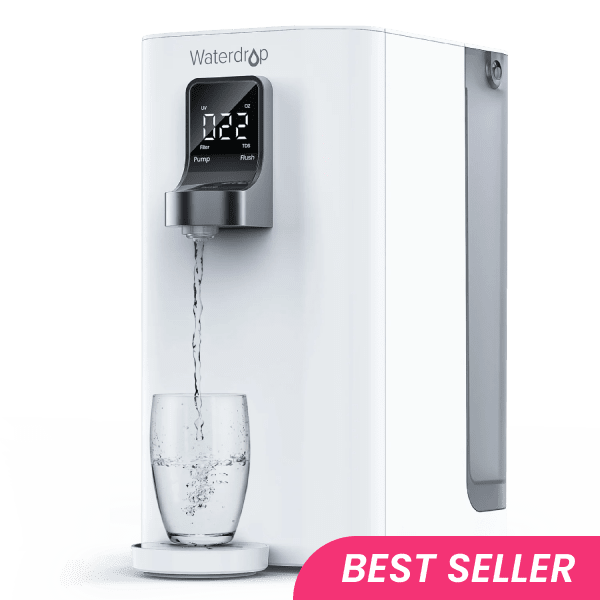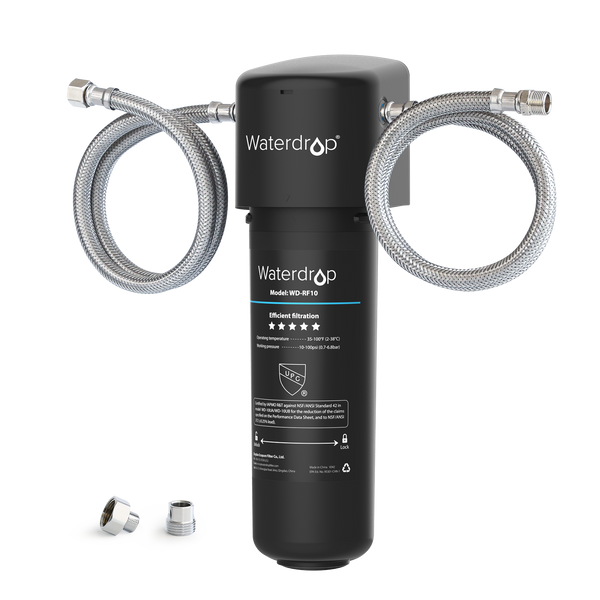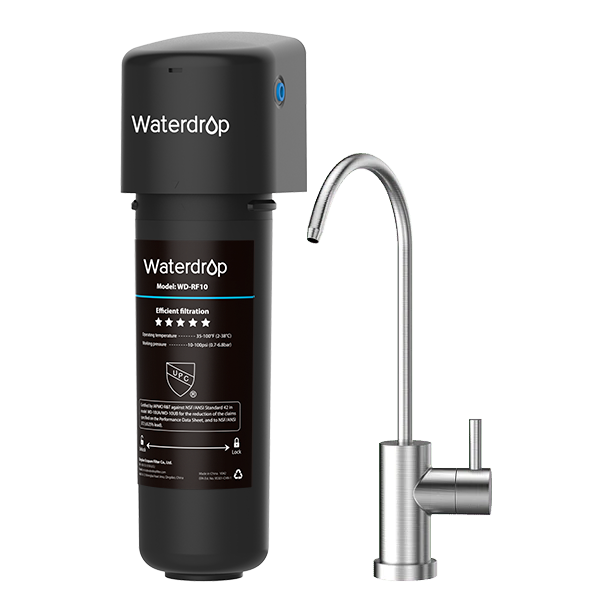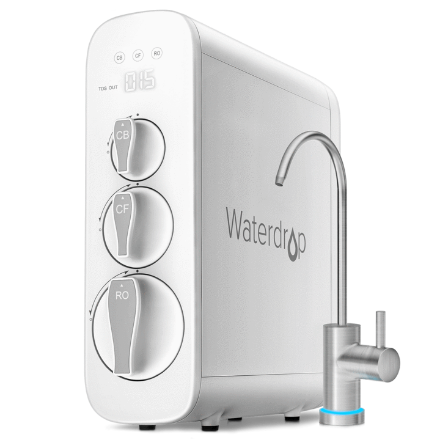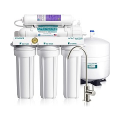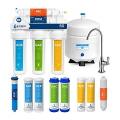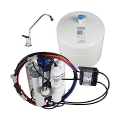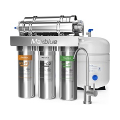What Is a Reverse Osmosis System and How Does It Work
by Dr. Jonathan Doyle - Updated October 12, 2021
• What Are Reverse Osmosis Water Filters? • How Does Reverse Osmosis Work? • Why Do
You Need A Water Filter? • Tank VS Tankless RO • Reverse Osmosis Water Filter With Tank Tankless Reverse Osmosis Water
Filter Reverse Osmosis System
Buying Guide • The Best Reverse Osmosis Systems Waterdrop G3 Reverse Osmosis Water
Filter System The APEC Essence
Series Water Filter System The
Express Water RO5DX Reverse Osmosis Filtration The NU Aqua Platinum Series 100GPD RO System The Home Master TMHP HydroPerfection RO
System The Maxblue Stainless
Steel Tankless RO System • Frequently Asked Questions • RO System Installation & Maintenance
What Are Reverse Osmosis Water Filters?
Reverse osmosis (RO) water filter uses the reverse
osmosis process in purifying water. RO filters are capable of removing water pollutants to make water safe and
clean for consumption.
Simple appliances like a camper's filter bottle use the RO filter as a
semipermeable membrane. RO membranes come with
other prefilters as a complete system because the membrane takes time to produce clean water, and they need
relatively clean feed water.
Usually, the system is set on sink-top filters, whole-house systems, or under-sink
systems.
How Does Reverse Osmosis Work?
RO filters get their name from the reverse osmosis process, and they also take
advantage of the process in filtering water. Naturally, osmosis happens when a solvent from a low concentration
region moves to a high concentration region through a permeable membrane. Reverse osmosis, on the other hand, is
the opposite of osmosis. Hydrostatic pressure forces the solvent to move from a high concentration to a low
concentration area during the process.
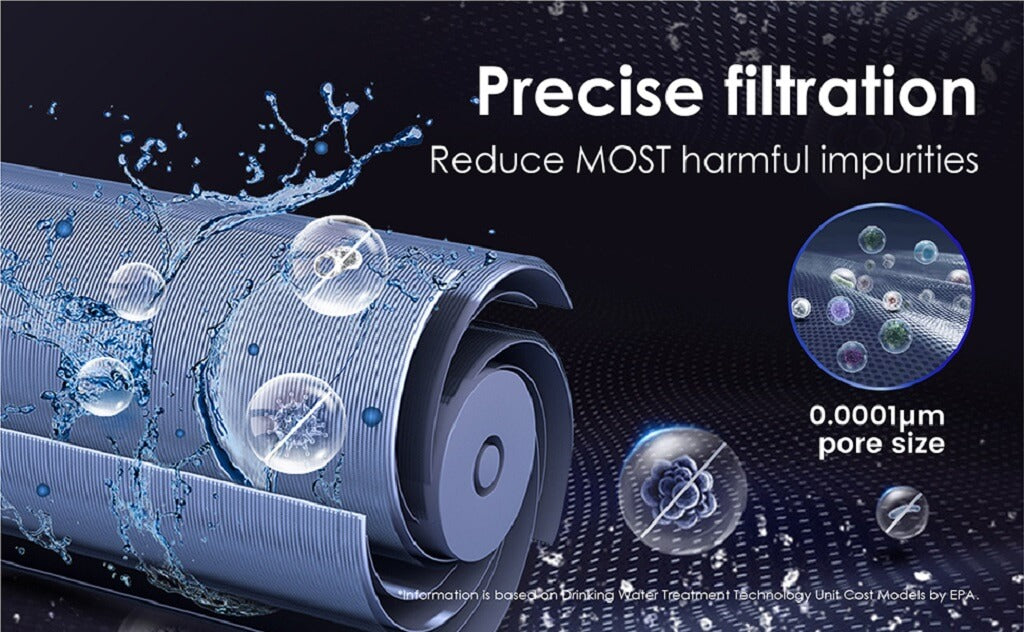
In simpler words, reverse osmosis can be explained in the context of water
filtration.
Water pressure forces the contaminated water to travel to the other side through
the membrane during reverse osmosis. The membrane's pores are usually small (sometimes even smaller than a human
red blood cell at 0.0001 microns) such that only pure water molecules can pass through. Therefore, pollutants
are rejected and washed away by wastewater.
RO filters are highly efficient at removing water pollutants. The filters can
remove more than 90% and up to 99.99% of contaminants, including heavy metals like lead, nickel, and mercury.
Furthermore, RO filters can remove algae, bacteria, viruses, hormones, pesticides, and herbicides.
Although reverse osmosis filters do not need electricity for operation, they need a
stable feed water pressure for forcing the pure water through the membrane. It is important to note that RO
filters won't work with very low water pressure.
Additionally, RO filters require a large amount of water for washing away the
contaminants every small amount of pure water makes. The most advanced systems with permeate pumps have pure
water to wastewater ratio of 1:1. Also, always check the mileage of your RO system; mileage varies across
different systems, and it is best to get highly efficient systems.
Why Do You Need A Water Filter?
You are probably checking out this article for various reasons, including wanting
safe, healthy drinking water for you and your loved ones or learning about different water filtration systems.
Unfortunately, tap water is no longer safe even if you have high-quality city or
well water. Also, there is no guarantee that bottled water is better than tap water.
The Environmental Working Group's (EWG) tap water database reports that 81% of Americans drinking water
contain carcinogenic contaminants. Also, 77% of Americans drink hexavalent chromium - the "Erin Brockovich"
chemical. Furthermore, water samples from all 50 states contain arsenic, chromium-6, disinfection byproducts,
and lead. The water samples also contain nitrates from fertilizers and radiological contaminants.
The EWG recommends reverse osmosis water filters
to filter drinking water effectively. RO filters can remove up to 99% of commonly dangerous water contaminants,
including lead, arsenic, nitrites, nitrates, selenium, chromium, and fluoride. The filters can also remove PFAS,
PFOS, PFOA, and GenX forever chemicals, cadmium, radium, phosphate, barium, chlorine, barium, bacteria, viruses,
cysts, and many more.
However, choosing your first system from the numerous reverse osmosis water
filtration systems can be pretty overwhelming, especially if you don't know much about water treatment.
Alternatively, you can check out the whole house water filter reviews if you decide
that a RO water filter system is not suitable for you.
Before purchasing individual RO systems, you can check below for our reverse
osmosis buying guide.
Tank VS Tankless RO
Reverse Osmosis Water Filter With Tank
The Traditional Reverse Osmosis (RO) Filtration System forces water through a
water-permeable membrane and a series of filtration devices. Although it is efficient in water purification, it
needs time to push the water molecules through the RO membrane, thus reducing the water quantity coming out of
your tap. Filtration managers found a solution to this problem by using a storage tank for filling purified
water ready for immediate use.
Pros
Advantages of the reverse osmosis water filter with tank include its affordability.
The system is more affordable than tankless options. Also, the system is suitable for storing purified water,
especially for emergencies. Furthermore, the system does not require a power supply except for the ones with a
pump or UV filter
Cons
A large system will require more setup space, and the water may taste off when
stored for too long.
Tankless Reverse Osmosis Water Filter
The latest iteration of the RO water filter is the Tankless Reverse Osmosis (RO) Filtration System.
This system is more compact, easier to manage, and produces fresher water. Furthermore, this system is designed
to provide the exact water purification level as the traditional RO system. However, the tankless RO system
takes up less storage space, and it purifies water when necessary instead of saving water in a storage tank.
Pros
The Tankless RO System uses a significantly small space compared to a Traditional
RO filter. Also, the water delivered is fresher because it is not stored in a tank. The system reduces your
water bill because it produces less wastewater than Traditional RO Systems.
Cons
Tankless RO Systems require a higher upfront investment, and the system needs
electric power before it can work. Also, this system is unreliable during emergencies because there is no
storage.
Reverse Osmosis System Buying Guide
8 Things of Purchasing an RO System
1. Water Source
Water delivered to your home feeds the Reverse Osmosis System. Although city or
municipal water is free of chemicals and bacteria, it may contain inorganic dissolved solids. Fortunately, RO
systems are designed to remove such solids. On the other hand, private well water may contain harmful pathogens
and chemicals and dissolved solids.
Reverse Osmosis systems are only efficient in treating city and well water as long
as they are pretreated. The pretreatment should remove bacteria and particles that could clog the membrane. It
is important to note that if your well water contains heavy metal contaminants like arsenic, you need a UV
system to disinfect the water once it leaves the storage tank.
2. Water Demand
It is best to consider you and your family's water consumption. According to
nutritionists, the ideal daily water intake should be half a person's weight in ounces. Therefore, if your
weight is 160 pounds, you should drink 80 ounces of water daily. It would be best to consider water used in ice
machines, refrigerators, and other appliances when considering your water demand. A Reverse Osmosis System
provides the quantity of water produced daily in GPD (gallons per day)
3. Water Pressure
With water pressure, reverse osmosis can force water through its membrane. For
house water pressures below 40psi, increasing the water pressure is necessary for reverse osmosis. You can use
an RO booster pump for this. Also, if you use a well water supply, ensure the tanks water pressure is high
enough for the RO system to work. Water containing a high level of dissolved solids can also increase the
pressure necessary for the RO system to produce clean water.
Additionally, residential reverse osmosis systems are point-of-use systems because
you can install them right where you need the filtered water. You can directly install most RO Systems under
your sink. Because Whole house reverse osmosis systems require a large storage tank and booster pump before
getting adequate pressure to deliver water to every point of your house, they are used less often.
4. Plumbing Requirements
It is advisable to consider few plumbing factors before purchasing a reverse
osmosis system. The first step is to check out the space under your kitchen sink; a reverse osmosis system takes
up a lot of space due to its multiple filters and large storage tank. Therefore, items stored under your sink
have to go. In addition, if you have a garbage disposal, fitting the reverse osmosis system below the sink will
be quite challenging.
5. Tank Size
RO tanks have sizes between 3 and 14 gallons. Nevertheless, reverse osmosis system
tank size can be quite deceiving. Usually, the actual tank capacity is less than the rated tank capacity because
RO storage tanks have a metal bladder and a bubble of air that creates enough pressure for pushing the water
through the faucet when the tap is open. For instance, a 4.5-gallon tank holds about 2 to 3 gallons of water. It
is advisable always to consider tank sizes when shopping for a RO tank system, ensuring it will meet your
family's daily water intake demand.
6. Wastewater
A significant criticism of the reverse osmosis water filtration system is its wastewater
creation. Standard water filters remove solid contaminants when water passes through the filter. In
contrast, RO systems remove contaminants in liquid form as wastewater, also known as brine. Conventional RO
Systems produce a considerable quantity of brine, about 3 to 25 gallons per gallon of purified water; keeping
this info in mind, you should only purchase RO systems with low wastewater to purified water ratio.
7. RO Style
Reverse Osmosis Systems are available in three cartridge styles - quick-change,
drop-in, and standard. Choosing a filter style should depend on the cost of maintenance, how easy it is to
maintain, or the level of environmental impact.
Quick-change cartridges are the simplest to maintain. However, they are the most
expensive and least eco-friendly. Furthermore, you can easily replace quick change filters. All you need do is
twist the old filter and pull it out. Next, put the new filter in the old filter's place and turn it in the
opposite direction. Nevertheless, this easy maintenance comes at a high price. Since the filter cartridges are
from plastic, they get wasted every time an old filter is discarded.
Drop-in and standard cartridges, on the other hand, are more difficult to replace
but are less expensive and more eco-friendly
When replacing a drop-in or standard filter, unscrew the housing and throw the
filter cartridge away. Next, place the new cartridge in and screw the housing back in place. Although you can
replace standard filters with compatible cartridges, you need exact replacements for drop-in systems.
Furthermore, reverse osmosis systems are available in multiple stages - three,
four, or five, depending on the number of prefilters and post-filters in the system. Usually, the RO membrane
does most of the work by removing dissolved solids. However, the additional prefilters and post-filters can
remove sediment, add chlorine, and polish and remineralize the water. Eventually, when the membrane wears out,
the prefilters can extend the membrane's life by giving an initial pass-through filter media.
8. Budget
Before budgeting for a reverse osmosis system, you should consider several factors,
including the system's cost, the installation cost, especially if you hire someone, and the ongoing maintenance
cost. Considering these factors will affect your choice of an RO system if your budget permits you to use one.
Pros and Cons of RO Systems
Using an RO system in your home has its pros and cons. The section below discusses
the significant points you should know to determine if the system is right for you.
Pros of an RO System
The System Produces Almost Pure Water
When Reverse osmosis systems filter water, the water is close to completely pure
water. RO systems are excellent for cleaning up water, and they are reliable for getting rid of dissolved
solids.
You can refer to the contaminants discussed above to understand how
comprehensive reverse osmosis systems are when it comes to purifying water
The System Does Not Get in The Way
Although getting a new water filtration system may be thrilling at first,
you realize that it is often in your way with time. Then, you start second-guessing your decision of
purchasing the system in the first place.
Many RO systems can conveniently fit under your kitchen sink, and this is a
significant advantage. You can use your RO system continuously without them hindering your work in the kitchen.
There Are No Installation Problems
RO systems are pretty easy to install compared to other water filtration systems.
You can easily install this system even if you are not quite experienced with working with household appliances.
Cons Of an RO System
Minerals Removal
Because of its highly efficient filtration, the RO system may filter out essential
minerals; This is the major drawback of the RO system. Considering your daily water demand, the filtered-out
minerals most likely accounts for a considerable part of your mineral intake.
Fortunately, remineralizing your water can minimize the
impact of this drawback.
The Components Of The Reverse Osmosis System
If you are in the market for a Reverse Osmosis System, you will discover the
biggest difference between this system is the quality of its manufacturing and the individual parts.
Pre-Filters
Pre-filters are essential for all reverse osmosis systems. This component filters
the water by removing large grains of sediment, like dirt, which can easily obstruct other parts of the system
preventing it from working properly.
Semipermeable Membrane
This membrane allows certain elements to pass through but not others. This is one
of the most important components of the reverse osmosis system. It traps unwanted elements from water including
harmful elements such as pesticides.
Post Filtering
Post filtering happens when the water leaves the pressurized tank but before it
goes into your tap for drinking. It gives the water one more treatment which removes any remaining carbon to
give water the best taste and appearance possible.
The Shut-Off Valve
The RO system would have a hard time operating efficiently without the shut-off
valve. The shut-off valve will turn off the system automatically when it senses the water tank is full.
The Flow Restrictor
The reverse osmosis filter feeds water through the filters very quickly which will
affect how much purified water passes into the storage tank after being filtered. The flow restrictor will
increase pressure to the water and push it through the membrane.
The Remineralization Filters
RO system removes everything from water so it's important to add healthy minerals
back in, such as calcium, zinc, magnesium, and iron. Even though you can get these minerals from food, it's
nifty to know you can also get them from your water. This is the purpose of the remineralization filter. This
filter brings minerals back into the water before it reaches the tank for storage.
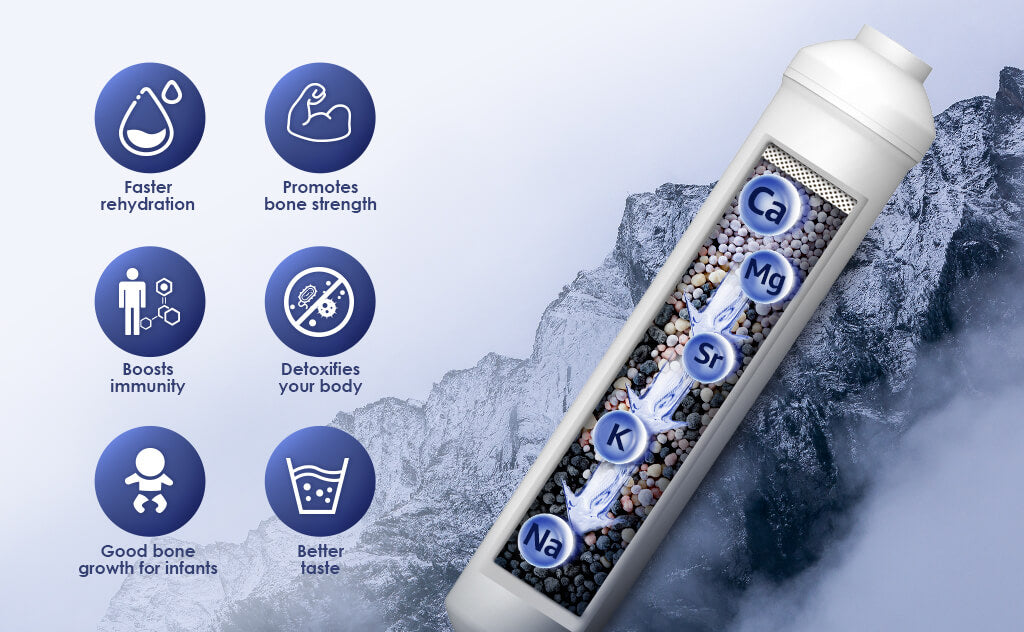
The Faucet
If you decide to get a reverse osmosis system, you will probably have to change out
your faucet for a faucet that comes with the system. The entire process is conveniently done in your kitchen
sink.
The Electric Pump
This pump works very much like the permeate pump in the system, it's just designed
differently. The pump uses a pressure switch to monitor the water pressure in the water storage tank. It will
turn on the pump to increase water pressure when needed.
Not all RO systems need an electric pump. However, if your water pressure falls
below 40 PSI, you don't want water waste but be more efficient, an electric pump will come in very handy.
The Best Reverse Osmosis Systems
Waterdrop G3 Reverse Osmosis Water Filter System
This system is very powerful under sink tankless RO water filtration system that
offers many excellent features. It comes with a sleek compact design that gives you plenty of pure, clean water
for you and your family by using a 7 stage filtration. The system has been tested and certified against NSF/ANSI
standard 58 so more than 90% of TDS can be reduced after completely flushing.
One really great feature when it's in use, an LED ring on your faucet will glow
with different colors to let you the status of the filters. In real-time, the panel on the system will deliver a
message regarding the condition of the filter and the TDS level of the filtered water. TDS is total dissolved
solids.
The APEC Essence Series Water Filter System
The APEC is another under sink reverse osmosis water filter system. It will produce
75 gallons of pure water each day. This is almost three times the amount of water that goes to waste as is
purified. This is attributed to the system's automatic shutoff valve and flow restrictor.
The water goes through 6 stages of filtration and provides remineralization by
adding minerals back into the water. Filtered water can taste really bland but remineralization brings back the
flavor of the water.
The Express Water RO5DX Reverse Osmosis Filtration
The Express Water System has been tested independently by the third-party ANAB that
uses the established NSF/ANSI Standards 42,58,401, and EPA 524.2 for the reduction of TDS, the taste of
chlorine, and odors. It's also shoulders above dealing with any arising compounds or secondary contaminants, or
other issues.
This system can be customized with additional filtering attachments. Another
feature includes a leak detection system. The Express Water RO system is very easy to install, especially for
those who believe in “Do It Yourself”. You will also get excellent support from experts who will walk you
through the entire installation process.
The NU Aqua Platinum Series 100GPD RO System
This system has been through rigorous testing in their lab to make sure it offers
consistent taste, clean and healthy water on demand. It features professional-grade high-quality fast connection
fittings, an elegant NSF 100% lead-free designed faucet, a double o-ring sealed filter housing, and will make
your countertop look fabulous while giving you a leak-free experience.
The NU Aqua Platinum Series 100GPD RO System is backed by a 5-year manufacturer
warranty and lifetime support. This system is considered to have the best support in the industry along with
guaranteed customer satisfaction.
The Home Master TMHP HydroPerfection RO System
If you want a system that is completely covered, you should consider this model. It
is loaded with all the best features found in a water filter. It offers a 5-stage reverse osmosis filtration
system that includes a Modular Sediment filter, Iron Filter With catalytic carbon, Ultra Violet Sterilizer
filter, RO Membrane, and a Remineralization filter.
Home Master claims this system is capable of removing up to 99% dissolved solids,
sediments, organic chemicals, heavy metals, and VOC. The UV light will kill any bacteria, viruses, or living
microorganisms found in well water.
The Maxblue Stainless Steel Tankless RO System
The Maxblue Stainless Steel RO System is setting new standards for RO systems. It
comes with all the standard filters you could possibly need and a tough housing for greater effectiveness. If
you want a finished and polished system that has everything you need without all the extras at a great cost,
then this is for you.
The Maxblue offers food-grade materials and a beautiful stainless steel finish. It
comes with an attractive look that will complement your area. It has been upgraded with a tougher and more
durable housing so it will not crack or leak. Its lifespan is 5 times longer than plastic systems.
This reverse osmosis water filter has a 1:1 drain ratio and will save 300% of the
water, due to its water-saving advanced technology.
Frequently Asked Questions
Why Should I Install an RO System Rather Than Using Mineral Water?
People prefer to drink mineral water because it is convenient and provides them
with the assurance that they are drinking safe water. The major problem with depending so much on mineral water
is that it generates a tremendous amount of
plastic trash. The world has already been suffering as a result of the amount of plastic in our
environment. It would help if you made an effort to prevent contributing to the situation.
RO systems provide the same water quality as traditional systems but without the
associated plastic trash.
Is It Worth It to Invest In A Reverse Osmosis System?
Getting a Reverse Osmosis (RO) unit is a very sensible move that a homeowner may
make for all purposes and goals. It not only provides healthier and best-tasting water, but it also
significantly reduces expenses. For example, A four-person family may save up to 30 cents per day on water
expenditures by using the most acceptable water filtration unit.
The typical American spends $100 per person on mineral water ($400 = four people).
The yearly operating expenses of an RO water filter device are around $100, so you may save up to $300 on water
bills. These are in addition to the numerous health benefits provided by reverse osmosis (RO) water. Drinking
clean, better-tasting, and filtered water is highly beneficial to your body.
For all these factors, and (RO) water filtration system is an excellent purchase.
How Long Will A RO System Work?
A RO system is typically expected to last 10 to 15 years. However, it is crucial to
note that the system, like other devices, has consumables that must be changed regularly. Filters and membranes
are examples of this.
Filters should be replaced once or either twice a year in most cases. The membrane,
on the other side, has a long lifetime of 2 to 4 years. The membrane's lifespan is determined by the condition
of water under which it is utilized.
Is Electricity Required to Run RO?
They do not operate on electricity; instead, they are powered by water pressure. If
you attach an electric pressure booster pump or a U.V. light, you need electricity.
Do I require a UV-Lighted Reverse Osmosis (RO) System?
Some Reverse Osmosis (RO) systems are equipped with UV lamps. Those UV lamps are beneficial
improvements. They help to purify water even more since they mainly target viruses and bacteria.
What Exactly Is TDS?
TDS is an abbreviation for dissolved solids in their complete state, present in all
surface and groundwater sources. It relates to all negative (anion) and positive (cation) inorganic ions
dissolved in the water. Sodium, magnesium, potassium, chloride, sulfates, carbonates, bicarbonates, and nitrates
are typical inorganic salts soluble in water.
How Much Sewage Produce Reverse Osmosis Systems?
True, an (RO) reverse osmosis filtration system uses more water than it generates,
but it's not that terrible in the perspective of wastage. After utilizing an RO (reverse osmosis) filtering unit
for two months, you won't notice any difference in your water bills.
How Noisy Is A RO System?
No, a functioning reverse osmosis (RO) system should not create any noise. You
should only hear a "gurgling" noise due to the sewage flowing from membrane to drain. The RO filter unit's
design prevents it from becoming disorganized. This is accomplished by draining the sewage from the unit via a
bridge.
Your reverse osmosis unit may occasionally produce a hissing sound. This implies an
issue with the system, and you should contact a local sewage treatment specialist right once. Water pressure,
air gaps, or leakage are possible culprits in this situation.
RO System Installation & Maintenance
Every one of the best reverse osmosis setups we've looked at so far needs some
level of setup before they can work. RO water filtering systems are intended to be securely installed, having
links to chilly water supply & waste pipes beneath a sink. Setup is identical for all these systems but
could be completed by anybody with minimal DIY abilities plus tools. Assuming a mounting hole for the purified
water tap doesn't exist, the only problematic step is drilling one in the counter or sink. The installation of a
whole home RO system or maybe any of our suggested whole house filtration systems is a little more complicated
and might even need the services of a plumber.
Look at our evaluations of countertop filtration systems, particularly countertop
RO filters, should these systems need excessive installation and therefore don't fit your circumstance. It's
feasible to just have purified water everywhere with three distinct categories to select from!
Types of Faucets
A conventional faucet or an air gap one is the different sorts of purified water
faucets accessible using an under-sink RO system. It's worth noting that installing an air gap tap using a
reverse Osmosis system is required in certain localities, even though it's often overlooked. Most sinks include
a covered opening, an opening for spray hose, or even a built-in soap dispenser which might be utilized with
your reverse Osmosis faucet. A ½" to 5/8" space is generally required for a basic RO faucet. Nevertheless,
typical air gap faucets often demand a 1 ½" hole outside the reach of most DIY abilities, mainly when a hole
must be drilled via countertop.
This need may influence your selection of a Reverse osmosis system. The rest of the
setup is straightforward after the opening for said faucet has gotten addressed.
Setup Procedure
1. Select an installation place - The first step is to choose a
suitable site for putting your reverse Osmosis water system. For most situations, the system will fit well
beneath your sink. However, you could opt to place it somewhere else if that is more convenient for you.
2. turn off the water — Installing a filtering system before
turning off the cold water valve is wrong. This is often located beneath the sink but is most likely linked to
copper pipe.
3. Attach your system with your cold-water supply — just before
you begin, turn on the cold faucet so all line pressure can be released. After that, you may start attaching the
RO filter with the water supply.
4. Attach your drain connection — During this point, assuming
there is visible rust in the drain connection, you should replace it before proceeding with the setup. If the
drain connection is in excellent condition, you're ready to move forward. Drill a hole inside the pipe's
exterior wall, then secure the drainage clamp. Adjust this clamp, taking care not to overtighten it. If the
system possesses one, then also add a shut-off switch at about this point.
5. Setup the faucet - It's typically an excellent method to put
your faucet relatively near where your prior faucet had been as reasonable while installing it. Suppose you
don't have one already, drill a hole in the sink. Place the faucet stem within the hole, then ensure the base
remains centered above the sink. Adjust the faucet, ensuring it's pointing in the spot you want to utilize it.
Then, just at the bottom of a stem, connect the necessary tubing.
6. Install your unit — Now is the time to install your unit
beneath the sink within the appropriate position. If you don't have a shelf to put the system on, you may have
to hang it on the wall.
Maintaining
All Reverse osmosis systems will require routine maintenance at some point. The
periods will vary depending on the kind of system and the water quality that reaches the filters.
Pre & post-filters should be replaced every six to twelve months or as needed
based on utilization volume. Companies propose timetables. However, the most efficient method is to monitor the
water quality beforehand, and afterward, the system treats it. It is possible to do it oneself if you have a TDS
meter. All RO membranes possess a lifespan of one to five years. Remember, the higher the input water condition,
the more the membrane would survive. One thing you can do to prolong the lifespan of the membrane would be to
replace the pre-filter membranes as required.
The procedure varies depending on the company; however, most reverse Osmosis
systems feature quickly replaceable filters. In certain situations, all required is to pull the filter out
towards the foundation lightly, hit a button present on the holder, and then the filter will come free. Some
filters come out, whereas the substitute goes in. Lastly, there are many sorts of filters found in housing
units. Such housings typically are unscrewed such that the filtering cartridge may be changed, then fitted back
into position. Except for a couple of minutes after few months to replace old filters, an under-sink RO system
requires no maintenance.
Contaminants Detected in Fruitland Water Special Service District
30
Contaminants
EXCEED EWG HEALTH GUIDELINES
EXCEED EWG HEALTH GUIDELINES
30 Total Contaminants in Your Water
Water Provider
Fruitland Water Special Service DistrictPopulation Affected
120,000Water Source
Ground waterExceeds Guidelines
Others Detected





